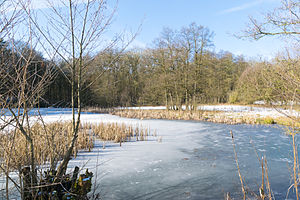Beller wood
|
Beller wood
|
||
|
frozen Ellernteich |
||
| location | Blomberg / Horn-Bad Meinberg , North Rhine-Westphalia , Germany | |
| surface | 462 ha | |
| Identifier | LIP-056, LIP-059 | |
| WDPA ID | 344615 , 329273 | |
| Natura 2000 ID | [http://www.naturschutzinformationen-nrw.de/natura2000-meldedok/de/fachinfo/listen/meldedok/DE-4120-303 DE-4120-303 DE-4120-303 ] | |
| Geographical location | 51 ° 54 ' N , 9 ° 1' E | |
|
|
||
| Setup date | 2004 | |
| administration | Lower landscape authority of the Lippe district | |
The Beller Holz or Beller Wald is a nature reserve in North Rhine-Westphalia . It lies between Bad Meinberg in the west and Belle in the east. The northern part of the nature reserve lies in the area of the city of Blomberg . The Norderteich nature reserve is directly adjacent to the south . The part protected according to the Habitats Directive covers 462 hectares. The vast majority of the forest is owned by the Lippe Regional Association .
history
In the 17th and 18th centuries the area was used as a hedge area. The vegetation consisted mainly of old trees, renewable trees were eaten by cattle. The area was divided into three districts: The Norderteicher forest in the south and the Meierholz in the west belonged to the Lords of Lippe, the so-called Nordholz had been owned by the town of Steinheim (Westphalia) since the 16th century . At that time, Beller Holz was probably a mixed oak forest and was used for fattening pigs in winter. During the Thirty Years War there was a military camp in the forest, parts of the forest fell victim to a fire or were used to supply firewood. In the 17th century there were repeated disputes about the use between the town of Steinheim and the villages with the right to dwell. As a result, the Herren zur Lippe bought back the north wood in 1733. At the end of the 18th century, about 240 hectares of the land were forested. In 1790, therefore, consideration was given to using the area for agricultural purposes and creating farmyards . Apparently there were not enough people willing to settle. With the Hudeablösungsgesetz in January 1850, the controlled forest management and with it the afforestation began. Many of the common oaks in the southern part of the forest also date from this period . Drainage measures were carried out in the late 19th century to improve the conditions for the oak trees.
Characteristic
Numerous small bodies of water flow through the forest. 88% of the forest consists of deciduous trees, mainly beeches, plus oaks, alders and ash trees. Half of the trees are 100 years old or more. The forest areas are predominantly composed of woodruff beech forest , hornbeam beech forest, and pedunculate oak and hornbeam forest. Protected biotopes include source areas, standing inland and running water areas, alluvial forests and reed beds . At Red List species are found
- kingfisher
- Common frog
- Gray heron
- Gray woodpecker
- Middle woodpecker
- Black woodpecker
- Black stork
- Pond frog
- Pond claw
- Reed Warbler
- brown owl
- Wood warbler
- Woodcock
- Little Grebe
Natural monuments
Two natural monuments have been identified in the Beller Holz. To the north of the federal highway 239 is the so-called Schlagetereiche, on the southern edge on the border to the Norderteich nature reserve near the Entenkrug guest house a group of seven oaks is also designated as a natural monument.
Web links
- Nature reserve “Beller Holz (Blomberg)” in the specialist information system of the State Office for Nature, Environment and Consumer Protection in North Rhine-Westphalia
- Nature reserve "Beller Holz (Horn-Bad Meinberg)" in the specialist information system of the State Office for Nature, Environment and Consumer Protection in North Rhine-Westphalia

